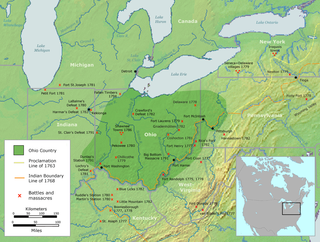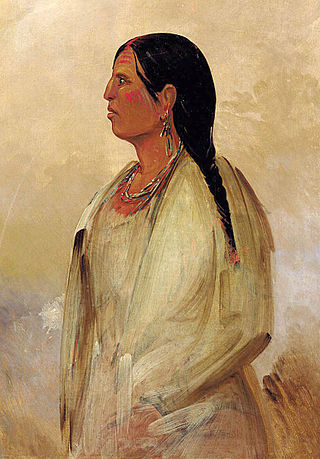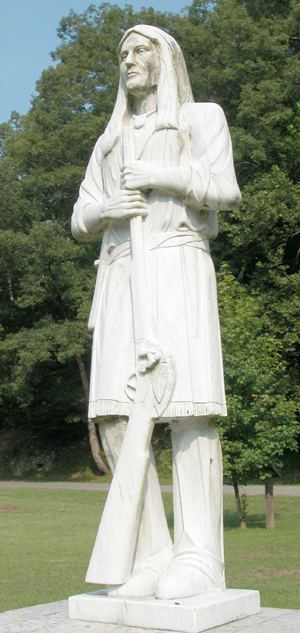
The Beaver Wars, also known as the Iroquois Wars or the French and Iroquois Wars were a series of conflicts fought intermittently during the 17th century in North America throughout the Saint Lawrence River valley in Canada and the Great Lakes region which pitted the Iroquois against the Hurons, northern Algonquians and their French allies. As a result of this conflict, the Iroquois destroyed several confederacies and tribes through warfare: the Hurons or Wendat, Erie, Neutral, Wenro, Petun, Susquehannock, Mohican and northern Algonquins whom they defeated and dispersed, some fleeing to neighbouring peoples and others assimilated, routed, or killed.

The Ohio Country, was a name used for a loosely defined region of colonial North America west of the Appalachian Mountains and south of Lake Erie.

John Reed Swanton was an American anthropologist, folklorist, and linguist who worked with Native American peoples throughout the United States. Swanton achieved recognition in the fields of ethnology and ethnohistory. He is particularly noted for his work with indigenous peoples of the Southeast and Pacific Northwest.

The Tunica-Biloxi Indian Tribe, formerly known as the Tunica-Biloxi Indian Tribe of Louisiana, is a federally recognized tribe of primarily Tunica and Biloxi people, located in east central Louisiana. Descendants of Ofo (Siouan-speakers), Avoyel, and Choctaw are also enrolled in the tribe.

The Quapaw or Arkansas, officially the Quapaw Nation, is a U.S. federally recognized tribe comprising about 5,600 citizens. Also known as the Ogáxpa or “Downstream” people, their ancestral homelands are traced from what is now the Ohio River, west to the Mississippi River to present-day St. Louis, south across present-day Arkansas and eastern and southern Oklahoma. The government forcibly removed them from Arkansas Territory in 1834. The tribal capital is Quapaw, Oklahoma.

Indigenous peoples of the Southeastern Woodlands, Southeastern cultures, or Southeast Indians are an ethnographic classification for Native Americans who have traditionally inhabited the area now part of the Southeastern United States and the northeastern border of Mexico, that share common cultural traits. This classification is a part of the Eastern Woodlands. The concept of a southeastern cultural region was developed by anthropologists, beginning with Otis Mason and Franz Boas in 1887. The boundaries of the region are defined more by shared cultural traits than by geographic distinctions. Because the cultures gradually instead of abruptly shift into Plains, Prairie, or Northeastern Woodlands cultures, scholars do not always agree on the exact limits of the Southeastern Woodland culture region. Shawnee, Powhatan, Waco, Tawakoni, Tonkawa, Karankawa, Quapaw, and Mosopelea are usually seen as marginally southeastern and their traditional lands represent the borders of the cultural region.
The Avoyel or Avoyelles were a small Native American tribe who at the time of European contact inhabited land near the mouth of the Red River at its confluence with the Atchafalaya River near present-day Marksville, Louisiana. The Avoyel are a member of the federally recognized Native American tribe and sovereign nation of the Tunica Biloxi Tribe of Louisiana.

The Saponi are a Native American tribe historically based in the Piedmont of North Carolina and Virginia. They spoke a Siouan language, related to the languages of the Tutelo, Biloxi, and Ofo.

The Eastern Siouan branch consists of various historical languages spoken by Siouan peoples of the Appalachian Plateau and Piedmont regions of present-day Virginia and the Carolinas. These languages are sometimes collectively referred to as Catawban, Tutelo, Tutelo-Saponi, or Yesah (Yesa:sahį). Eastern Siouan languages were historical spoken by the Monacan Indian Nation, Haliwa-Saponi, Catawba/Iswa, Occaneechi, and Waccamaw peoples. They possibly represent a dialect continuum with Ohio Valley Siouan languages. The Catawban family is a branch of the larger Siouan a.k.a. Siouan–Catawban family.

The Manahoac, also recorded as Mahock, were a small group of Siouan-language Native Americans in northern Virginia at the time of European contact. They numbered approximately 1,000 and lived primarily along the Rappahannock River west of modern Fredericksburg and the Fall Line, and east of the Blue Ridge Mountains. They united with the Monacan, the Occaneechi, the Saponi and the Tutelo. They disappeared from the historical record after 1728.

The Biloxi tribe are Native Americans of the Siouan language family. They call themselves by the autonym Tanêks(a) in Siouan Biloxi language. When first encountered by Europeans in 1699, the Biloxi inhabited an area near the coast of the Gulf of Mexico near what is now the city of Biloxi, Mississippi. They were eventually forced west into Louisiana and eastern Texas. The Biloxi language--Tanêksąyaa ade--has been extinct since the 1930s, when the last known semi-speaker, Emma Jackson, died.

The Tutelo were Native American people living above the Fall Line in present-day Virginia and West Virginia. They spoke a dialect of the Siouan Tutelo language thought to be similar to that of their neighbors, the Monacan and Manahoac nations.

The Moneton were a historical Native American tribe from West Virginia. In the late 17th century, they lived in the Kanawha Valley near the Kanawha and New Rivers.
The Koroa were one of the groups of Indigenous people of the Southeastern Woodlands who lived in the Mississippi Valley before French colonization. The Koroa lived in the Yazoo River basin in present-day northwest Mississippi.

The Ofo language was a language spoken by the Ofo people, also called the Mosopelea, in what is now Ohio, along the Ohio River, until about 1673. The tribe moved south along the Mississippi River to Mississippi, near the Natchez people, and then to Louisiana, settling near the Tunica.

The Mingo people are an Iroquoian group of Native Americans, primarily Seneca and Cayuga, who migrated west from New York to the Ohio Country in the mid-18th century, and their descendants. Some Susquehannock survivors also joined them, and assimilated. Anglo-Americans called these migrants mingos, a corruption of mingwe, an Eastern Algonquian name for Iroquoian-language groups in general. The Mingo have also been called "Ohio Iroquois" and "Ohio Seneca".

The Tunica people are a group of linguistically and culturally related Native American tribes in the Mississippi River Valley, which include the Tunica ; the Yazoo; the Koroa ; and possibly the Tioux. They first encountered Europeans in 1541 – members of the Hernando de Soto expedition.

The protohistoric period of the state of West Virginia in the United States began in the mid-sixteenth century with the arrival of European trade goods. Explorers and colonists brought these goods to the eastern and southern coasts of North America and were brought inland by native trade routes. This was a period characterized by increased intertribal strife, rapid population decline, the abandonment of traditional life styles, and the extinction and migrations of many Native American groups.
The Pensacola were a Native American people who lived in the western part of what is now the Florida Panhandle and southwestern Alabama for centuries before first contact with Europeans until early in the 18th century. They spoke a Muskogean language. They are the source of the name of Pensacola Bay and the city of Pensacola. They lived in the area until the mid-18th century, but were thereafter assimilated into other groups.
The Ohio Valley Siouan, or Southeastern Siouan, languages are a subfamily of the Western Siouan languages, far to the east and south of the Mississippi River. The group has Ofo and Biloxi, in the Lower Mississippi River valley, and Tutelo, historically spoken in Virginia, near the territory of the Catawban languages. All of the languages are now extinct.















